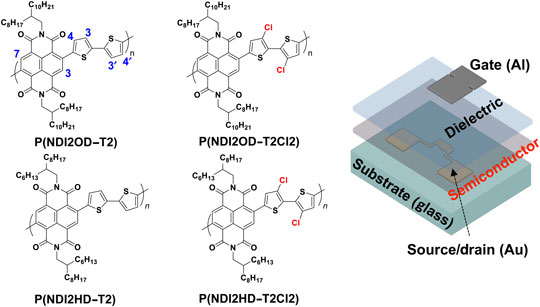Crossref Citations
This article has been cited by the following publications. This list is generated based on data provided by
Crossref.
Erdmann, Tim
Fabiano, Simone
Milián‐Medina, Begoña
Hanifi, David
Chen, Zhihua
Berggren, Magnus
Gierschner, Johannes
Salleo, Alberto
Kiriy, Anton
Voit, Brigitte
and
Facchetti, Antonio
2016.
Naphthalenediimide Polymers with Finely Tuned In‐Chain π‐Conjugation: Electronic Structure, Film Microstructure, and Charge Transport Properties.
Advanced Materials,
Vol. 28,
Issue. 41,
p.
9169.
Ryu, Gi-Seong
Chen, Zhihua
Fabiano, Simone
Usta, Hakan
Noh, Yong-Young
and
Fachetti, Antonio
2016.
Naphthalene diimide-based polymeric semiconductors. Effect of chlorine incorporation and n-channel transistors operating in water- CORRIGENDUM.
MRS Communications,
Vol. 6,
Issue. 1,
p.
69.
Shi, Longxian
Guo, Yunlong
Hu, Wenping
and
Liu, Yunqi
2017.
Design and effective synthesis methods for high-performance polymer semiconductors in organic field-effect transistors.
Materials Chemistry Frontiers,
Vol. 1,
Issue. 12,
p.
2423.
Lee, Eun Kwang
Lee, Moo Yeol
Park, Cheol Hee
Lee, Hae Rang
and
Oh, Joon Hak
2017.
Toward Environmentally Robust Organic Electronics: Approaches and Applications.
Advanced Materials,
Vol. 29,
Issue. 44,
Yang, Jie
Zhao, Zhiyuan
Wang, Shuai
Guo, Yunlong
and
Liu, Yunqi
2018.
Insight into High-Performance Conjugated Polymers for Organic Field-Effect Transistors.
Chem,
Vol. 4,
Issue. 12,
p.
2748.
Chen, Hui
Hu, Zhiming
Wang, Huan
Liu, Longzhu
Chao, Pengjie
Qu, Jianfei
Chen, Wei
Liu, Anhua
and
He, Feng
2018.
A Chlorinated π-Conjugated Polymer Donor for Efficient Organic Solar Cells.
Joule,
Vol. 2,
Issue. 8,
p.
1623.
Nketia-Yawson, Benjamin
Tabi, Grace Dansoa
and
Noh, Yong-Young
2018.
Low-voltage operated solid-state electrolyte-gated ambipolar organic field-effect transistors.
Organic Electronics,
Vol. 52,
Issue. ,
p.
257.
Sun, Hengda
Vagin, Mikhail
Wang, Suhao
Crispin, Xavier
Forchheimer, Robert
Berggren, Magnus
and
Fabiano, Simone
2018.
Complementary Logic Circuits Based on High‐Performance n‐Type Organic Electrochemical Transistors.
Advanced Materials,
Vol. 30,
Issue. 9,
Ozdemir, Resul
Park, Sangyun
Deneme, İbrahim
Park, Yonghan
Zorlu, Yunus
Alidagi, Husniye Ardic
Harmandar, Kevser
Kim, Choongik
and
Usta, Hakan
2018.
Triisopropylsilylethynyl-substituted indenofluorenes: carbonyl versus dicyanovinylene functionalization in one-dimensional molecular crystals and solution-processed n-channel OFETs.
Organic Chemistry Frontiers,
Vol. 5,
Issue. 20,
p.
2912.
Tabi, Grace Dansoa
Nketia-Yawson, Benjamin
Kang, So-Huei
Yang, Changduk
and
Noh, Yong-Young
2018.
High performance p-type chlorinated-benzothiadiazole-based polymer electrolyte gated organic field-effect transistors.
Organic Electronics,
Vol. 54,
Issue. ,
p.
255.
Li, Hui
Shi, Wei
Song, Jian
Jang, Hyun-June
Dailey, Jennifer
Yu, Junsheng
and
Katz, Howard E.
2019.
Chemical and Biomolecule Sensing with Organic Field-Effect Transistors.
Chemical Reviews,
Vol. 119,
Issue. 1,
p.
3.
Goel, Mahima
Heinrich, C. David
Krauss, Gert
and
Thelakkat, Mukundan
2019.
Principles of Structural Design of Conjugated Polymers Showing Excellent Charge Transport toward Thermoelectrics and Bioelectronics Applications.
Macromolecular Rapid Communications,
Vol. 40,
Issue. 10,
Shi, Shengbin
Chen, Peng
Wang, Hang
Koh, Chang Woo
Uddin, Mohammad Afsar
Liu, Bin
Liao, Qiaogan
Feng, Kui
Woo, Han Young
Xiao, Guomin
and
Guo, Xugang
2020.
Ultranarrow Bandgap Naphthalenediimide‐Dialkylbifuran‐Based Copolymers with High‐Performance Organic Thin‐Film Transistors and All‐Polymer Solar Cells.
Macromolecular Rapid Communications,
Vol. 41,
Issue. 12,
Kim, Dahye
Zhu, Huihui
Liu, Ao
Kim, Hee Su
Noh, Yong-Young
and
Hwang, Do-Hoon
2020.
Highly Ambient-Stable Organic Thin-Film Transistors Fabricated Using Naphthalene Diimide and Thienylene–Vinylene–Thienylene-Based n-Type Polymers with Different Electron-Withdrawing Groups.
The Journal of Physical Chemistry C,
Vol. 124,
Issue. 38,
p.
20784.
Shahid, Bilal
Zhu, Dangqiang
Wang, Qian
Yuan, Xiyue
Ismail, Irfan
Wu, Yao
Du, Zurong
and
Yang, Renqiang
2020.
Halogenation effect promoted low bandgap polymers based on asymmetric isoindigo unit with low energy loss.
Polymer International,
Vol. 69,
Issue. 6,
p.
564.
Wang, Lixin
Park, Jin Su
Lee, Hyun Gyeong
Kim, Geon-U
Kim, Donguk
Kim, Changkyun
Lee, Seungjin
Kim, Felix Sunjoo
and
Kim, Bumjoon J.
2020.
Impact of Chlorination Patterns of Naphthalenediimide-Based Polymers on Aggregated Structure, Crystallinity, and Device Performance of All-Polymer Solar Cells and Organic Transistors.
ACS Applied Materials & Interfaces,
Vol. 12,
Issue. 50,
p.
56240.
Li, Yuxiang
Jia, Zhiyan
Zhang, Qilin
Wu, Ziang
Qin, Hongmei
Yang, Jianye
Wen, Shuguang
Woo, Han Young
Ma, Wanli
Yang, Renqiang
and
Yuan, Jianyu
2020.
Toward Efficient All-Polymer Solar Cells via Halogenation on Polymer Acceptors.
ACS Applied Materials & Interfaces,
Vol. 12,
Issue. 29,
p.
33028.
Wei, Huan
Liu, Yu
Liu, Zhiqiang
Guo, Jing
Chen, Ping‐An
Qiu, Xincan
Dai, Gaole
Li, Yuxiang
Yuan, Jianyu
Liao, Lei
and
Hu, Yuanyuan
2020.
Effect of Backbone Fluorine and Chlorine Substitution on Charge‐Transport Properties of Naphthalenediimide‐Based Polymer Semiconductors.
Advanced Electronic Materials,
Vol. 6,
Issue. 4,
Lenaerts, Ruben
Devisscher, Dries
Pirotte, Geert
Gielen, Sam
Mertens, Sigurd
Cardeynaels, Tom
Champagne, Benoît
Lutsen, Laurence
Vanderzande, Dirk
Adriaensens, Peter
Verstappen, Pieter
Vandewal, Koen
and
Maes, Wouter
2020.
The effect of halogenation on PBDTT-TQxT based non-fullerene polymer solar cells – Chlorination vs fluorination.
Dyes and Pigments,
Vol. 181,
Issue. ,
p.
108577.
Bhosale, Sheshanath V.
Al Kobaisi, Mohammad
Jadhav, Ratan W.
Morajkar, Pranay P.
Jones, Lathe A.
and
George, Subi
2021.
Naphthalene diimides: perspectives and promise.
Chemical Society Reviews,
Vol. 50,
Issue. 17,
p.
9845.





